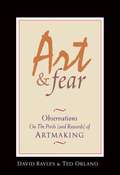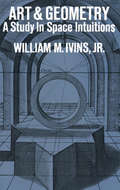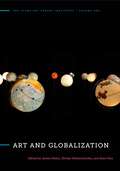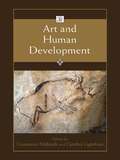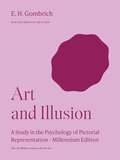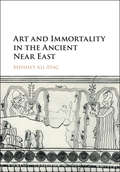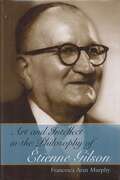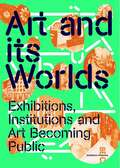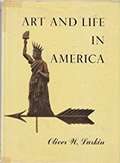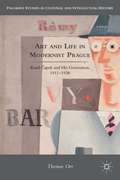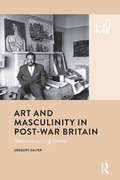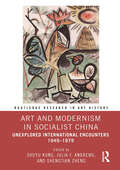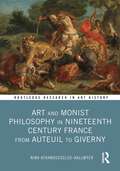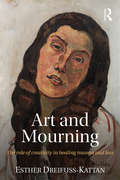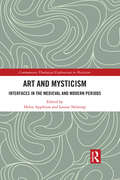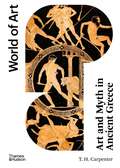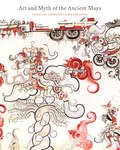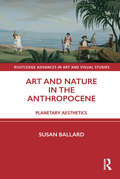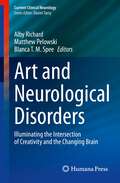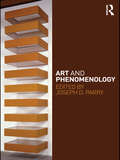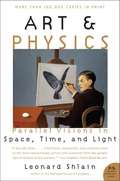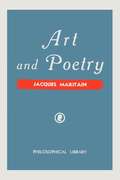- Table View
- List View
Art and Fear: Observations On the Perils (and Rewards) of Artmaking
by David Bayles Ted Orland"This is a book about making art. Ordinary art. Ordinary art means something like: all art not made by Mozart. After all, art is rarely made by Mozart-like people; essentially--statistically speaking--there aren't any people like that. Geniuses get made once-a-century or so, yet good art gets made all the time, so to equate the making of art with the workings of genius removes this intimately human activity to a strangely unreachable and unknowable place. For all practical purposes making art can be examined in great detail without ever getting entangled in the very remote problems of genius. " ---from the Introduction Art & Fear explores the way art gets made, the reasons it often doesn't get made, and the nature of the difficulties that cause so many artists to give up along the way. The book's co-authors, David Bayles and Ted Orland, are themselves both working artists, grappling daily with the problems of making art in the real world. Their insights and observations, drawn from personal experience, provide an incisive view into the world of art as it is experienced by artmakers themselves. This is not your typical self-help book. This is a book written by artists, for artists --- it's about what it feels like when artists sit down at their easel or keyboard, in their studio or performance space, trying to do the work they need to do. First published in 1994, Art & Fear quickly became an underground classic. Word-of-mouth response alone--now enhanced by internet posting--has placed it among the best-selling books on artmaking and creativity nationally. Art & Fear has attracted a remarkably diverse audience, ranging from beginning to accomplished artists in every medium, and including an exceptional concentration among students and teachers. The original Capra Press edition of Art & Fear sold 80,000 copies. An excerpt: Today, more than it was however many years ago, art is hard because you have to keep after it so consistently. On so many different fronts. For so little external reward. Artists become veteran artists only by making peace not just with themselves, but with a huge range of issues. You have to find your work. . .
Art and Form: From Roger Fry to Global Modernism (Refiguring Modernism #28)
by Sam RoseThis important new study reevaluates British art writing and the rise of formalism in the visual arts from 1900 to 1939. Taking Roger Fry as his starting point, Sam Rose rethinks how ideas about form influenced modernist culture and the movement’s significance to art history today.In the context of modernism, formalist critics are often thought to be interested in art rather than life, a stance exemplified in their support for abstract works that exclude the world outside. But through careful attention to early twentieth-century connoisseurship, aesthetics, art education, design, and art in colonial Nigeria and India, Rose builds an expanded account of form based on its engagement with the social world. Art and Form thus opens discussions on a range of urgent topics in art writing, from its history and the constructions of high and low culture to the idea of global modernism. Rose demonstrates the true breadth of formalism and shows how it lends a new richness to thought about art and visual culture in the early to mid-twentieth century.Accessibly written and analytically sophisticated, Art and Form opens exciting new paths of inquiry into the meaning and lasting importance of formalism and its ties to modernism. It will be invaluable for scholars and enthusiasts of art history and visual culture.
Art and Geometry: A Study in Space Intuitions
by William M. IvinsOne of Western civilization's jealously guarded myths is that of Greek cultural supremacy. In this controversial study, William Ivins shows that the limitations of the Greek worldview actually hampered the development of the arts and sciences and gives a stimulating history of the new ideas of the Renaissance, especially in painting and geometry, that freed us from ancient misconceptions. Beginning with the Greeks, the author explains for the general reader the differences between ancient and Renaissance painting and sculpture, proving that the curiously static quality of Greek art arose from a misunderstanding of the laws of perspective. He then shows how this misunderstanding was corrected by Alberti, Pelerin, Durer, and other Renaissance artists who provided the first fruitful investigations of perspective. From there to projective geometry was but a step, and the author covers this major advance in our knowledge through the work of Nicholas of Cusa, Kepler, and Desargues. This book is perhaps the only concise history in English of the development of mathematical perspective and projective geometry. But the author's ability to relate styles in art to advances in geometry and his ingenious theory of the modern "visual" worldview and the Greek "tactile" worldview mean that his book will be provocative not only to mathematical historians but also to art historians and to anyone concerned with the history of thought, from philosopher to layman.
Art and Globalization (The Stone Art Theory Institutes #1)
by James Elkins Zhivka Valiavicharska Alice KimThe “biennale culture” now determines much of the art world. Literature on the worldwide dissemination of art assumes nationalism and ethnic identity, but rarely analyzes it. At the same time there is extensive theorizing about globalization in political theory, cultural studies, postcolonial theory, political economy, sociology, and anthropology. Art and Globalization brings political and cultural theorists together with writers and historians concerned specifically with the visual arts in order to test the limits of the conceptualization of the global in art. Among the major writers on contemporary international art represented in this book are Rasheed Araeen, Joaquín Barriendos, Susan Buck-Morss, John Clark, Iftikhar Dadi, T. J. Demos, Néstor García Canclini, Charles Green, Suman Gupta, Harry Harootunian, Michael Ann Holly, Shigemi Inaga, Fredric Jameson, Caroline Jones, Thomas DaCosta Kaufmann, Anthony D. King, Partha Mitter, Keith Moxey, Saskia Sassen, Ming Tiampo, and C. J. W.-L. Wee. Art and Globalization is the first book in the Stone Art Theory Institutes Series. The five volumes, each on a different theoretical issue in contemporary art, build on conversations held in intensive, weeklong closed meetings. Each volume begins with edited and annotated transcripts of those meetings, followed by assessments written by a wide community of artists, scholars, historians, theorists, and critics. The result is a series of well-informed, contentious, open-ended dialogues about the most difficult theoretical and philosophical problems we face in rethinking the arts today.
Art and Human Development (Jean Piaget Symposia Series)
by Cynthia Lightfoot Constance MilbrathThis interdisciplinary volume explores art, its development, and its role in the construction of knowledge. Presenting theory and research on artistic development as a cultural and creative endeavor, contributors examine the origins of human art during the Paleolithic cultural revolution, as part of a modern cultural transformation, in the growth of a creative artist, and in developing children. Target chapters expressing the disciplinary perspectives of psychology, archaeology, communications, education, and the performing arts are followed by commentaries from internationally acclaimed scholars of human development. Part 1 explores how cultures harness and exploit the arts to give expression to values, social practices, and traditions. This section traces the emergence of new art forms that arose during social unrest, including the symbolization of spiritual beliefs expressed on the walls of Paleolithic caves, and the racial identity and cultural values expressed in the media of the hip-hop generation. Part 2 examines the journeys of a composer and a group of students to highlight the process of becoming an artist and the role education plays in its development. The book concludes with a focus on the development of aesthetic appreciation and artistic activity in childhood and adolescence, including, for example, how a child’s developing theory of mind affects appreciation for the arts, and how developing empathy and emotional regulation contribute to the cognitive and affective underpinnings of acting in adolescence. As a whole contributors explore the developmental, sociocultural, and evolutionary processes that make the creation and experience of art possible. Intended for researchers and advanced students in both human development and the arts, this book will also serve as a textbook for advanced courses on psychology and the arts and/or special topics courses in cognitive and/or human development.
Art and Illusion: A Study in the Psychology of Pictorial Representation - Millennium Edition (The A. W. Mellon Lectures in the Fine Arts #5)
by E. H. GombrichA groundbreaking account of perception and art, from one of the twentieth century’s most important art historiansE. H. Gombrich is widely considered to be one of the most influential art historians of the twentieth century, and Art and Illusion is generally agreed to be his most important book. Bridging science and the humanities, this classic work examines the history and psychology of pictorial representation in light of modern theories of information and learning in visual perception. Searching for a rational explanation of the changing styles of art, Gombrich reexamines ideas about the imitation of nature and the function of tradition. In testing his arguments, he ranges over the history of art, from the ancient Greeks, Leonardo, and Rembrandt to the impressionists and the cubists. But the triumphant originality of Art and Illusion is that Gombrich is less concerned with the artists than with the psychological experience of the viewers of their work.Please note: All images in this ebook are presented in black and white and have been reduced in size.
Art and Immortality in the Ancient Near East
by Mehmet-Ali AtaçDiscussions of apocalyptic thought and its sources in the ancient Near East, particularly Mesopotamia, have a long scholarly history, with a renewed interest and focus in the recent decades. Outside Assyriological scholarship as well, studies of the apocalyptic give significant credit to the ancient Near East, especially Babylonia and Iran, as potential sources for the manifestations of this phenomenon in the Hellenistic period. The emphasis on kingship and empire in apocalyptic modes of thinking warrants special attention paid to the regal art of ancient Mesopotamia and adjacent areas in its potential to express the relevant notions.<P><P>In this book, Mehmet-Ali Ataç demonstrates the importance of visual evidence as a source for apocalyptic thought. Focusing on the so-called investiture painting from Mari, he relates it to parallel evidence from the visual traditions of the Assyrian Empire, ancient Egypt, and Hittite Anatolia.<P> Proposes a new way of looking at the imagery of ancient Near Eastern art, and favors a metaphysical perspective.<P> Adopts a diachronic approach and deals with a number of periods and cultures of the ancient Near East, including Egypt, in a comparative framework.<P> Puts the study of apocalyptic thought in the forefront of the interpretation of the art of the ancient Near East of the second and first millennia BCE.
Art and Intellect in the Philosophy of Étienne Gilson (The Eric Voegelin Institute Series in Political Philosophy #Volume One)
by Francesca Aran MurphyIn Art and Intellect in the Philosophy of Étienne Gilson, Francesca Aran Murphy tells the story of this French philosopher’s struggle to reconcile faith and reason. In his lifetime, Gilson often stood alone in presenting Saint Thomas Aquinas as a theologian, one whose philosophy came from his faith. Today, Gilson’s view is becoming the prevalent one. Murphy provides us with an intellectual biography of this Thomist leader throughout the stages of his scholarly development. <p><p>Murphy covers more than a half century of Gilson’s life while reminding readers of the political and social realities that confronted intellectuals of the early twentieth century. She shows the effects inner-church politics had on Gilson and his contemporaries such as Alfred Loisy, Lucien Lévy Bruhl, Charles Maurras, Henri de Lubac, Marie-Dominique Chenu, and Jacques Maritain, while also contextualizing Gilson’s own life and thoughts in relation to these philosophers and theologians. <p><p>These great thinkers, along with Gilson, continue to be sources of important intellectual debate among scholars, as do the political periods through which Gilson’s story threads—World Wars I and II, the rise and fall of Fascism, and the political upheavals of Europe. By placing Gilson’s twentieth-century Catholic life against a dramatic background of opposed political allegiances, clashing spiritualities, and warring ideas of philosophy, this book shows how rival factions each used their own interpretations of Thomas Aquinas to legitimate their conceptions of the Catholic Church. <p><p>In Art and Intellect in the Philosophy of Étienne Gilson, Murphy shows Gilson’s early openness to the artistic revolution of the Cubist and the Expressionist movements and how his love of art inspired his existential theology. She demonstrates the influence that Henri Bergson continued to have on Gilson and how Gilson tried to bring together the intellectual, Dominican side of Christianity with the charismatic, experiential Franciscan side. <p><p>Murphy concludes with a chapter on issues inspired by the Gilsonist tradition as developed by recent thinkers. This volume makes an original contribution to the study of Gilson, for the first time providing an organic and synthetic treatment of this major spiritual philosopher of modern times.
Art and Its Objects
by Richard WollheimRichard Wollheim's classic reflection on art considers central questions regarding expression, representation, style, the significance of the artist's intention and the essentially historical nature of art. Presented in a fresh series livery for the twenty-first century, with a specially commissioned preface written by Richard Eldridge, illuminating its continuing importance and relevance to philosophical enquiry, Art and its Objects continues to be a perceptive and engaging introduction to the questions and philosophical issues raised by works of art and the part they play in our culture and society. Wollheim's insights into theories of art, criticism, perception and the nature of aesthetic value make this one of the most influential works on aesthetics of the twentieth century.
Art and Its Worlds: Exhibitions, Institutions, and Art Becoming Public (Exhibition Histories #12)
by AxelrodAn anthology of essays on art’s relation to the public realm since 1989. <p><p> This critical anthology explores the myriad histories and worlds through which art is produced and experienced. It is guided by the following questions: How are the “global” and the “located” shaped and understood in disparate contexts and times? How have artists experimented with modes of exhibition-making and public presentation? <p><p>Key essays previously published by Afterall are included alongside new image-led presentations, translated material and commissioned texts. The anthology addresses the topic in both theoretical terms and through case studies. <p><p>Contributors include: Silvia Rivera Cusicanqui, Miguel A. López, Eddie Chambers, Francesca Recchia, Pablo Lafuente, Philippe Pirotte, Ntone Edjabe, Clémentine Deliss, Khwezi Gule, Charles Gaines, David Teh, Ekaterina Degot, Ana Teixeira Pinto, María Berríos, Mujeres Creando, Comunitario del Valle de Xico, Tonika Sealy Thompson and Stefano Harney.
Art and Life in America
by Oliver W. LarkinThe history of art in America.<P><P> Pulitzer Prize Winner
Art and Life in Modernist Prague
by Thomas OrtIn most contemporary historical writing the picture of modern life in Habsburg Central Europe is a gloomy story of the failure of rationalism and the rise of protofascist movements. This book tells a different story, focusing on the Czech writers and artists distinguished by their optimistic view of the world in the years before WWI.
Art and Masculinity in Post-War Britain: Reconstructing Home (Home Ser.)
by Gregory SalterIn this book, Gregory Salter traces how artists represented home and masculinities in the period of social and personal reconstruction after the Second World War in Britain. Salter considers home as an unstable entity at this historical moment, imbued with the optimism and hopes of post-war recovery while continuing to resonate with the memories and traumas of wartime. Artists examined in the book include John Bratby, Francis Bacon, Keith Vaughan, Francis Newton Souza and Victor Pasmore. Case studies featured range from the nuclear family and the body, to the nation. Combined, they present an argument that art enables an understanding of post-war reconstruction as a temporally unstable, long-term phenomenon which placed conceptions of home and masculinity at the heart of its aims. Art and Masculinity in Post-War Britain sheds new light on how the fluid concepts of society, nation, masculinity and home interacted and influenced each other at this critical period in history and will be of interest to anyone studying art history, anthropology, sociology, history and cultural and heritage studies.
Art and Merchandise in Keith Haring’s Pop Shop (Routledge Advances in Art and Visual Studies)
by Amy RaffelAs one of the first academic monogrpahs on Keith Haring, this book uses the Pop Shop, a previously overlooked enterprise, and artist merchandising as tools to reconsider the significance and legacy of Haring’s career as a whole. Haring developed an alternative approach to both the marketing and the social efficacy of art: he controlled the sales and distribution of his merchandise, while also promulgating his belief in accessibility and community activism. He proved that mass-produced objects can be used strategically to form a community and create social change. Furthermore, looking beyond the 1980s, into the 1990s and 2000s, Haring and his shop prefigured artists’ emerging, self-aware involvement with the mass media, and the art world’s growing dependence on marketing and commercialism. The book will be of interest to scholars or students studying art history, consumer culture, cultural studies, media studies, or market studies, as well as anyone with a curiosity about Haring and his work, the 1980s art scene in New York, the East Village, street art, art activism, and art merchandising.
Art and Modernism in Socialist China: Unexplored International Encounters 1949–1979 (Routledge Research in Art History)
by Shuyu Kong Julia F. Andrews Shengtian ZhengThis edited volume will be the first book examining the art history of China’s socialist period from the perspective of modernism, modernity, and global interactions.The majority of chapters are based on newly available archival materials and fresh critical frameworks/concepts. By shifting the frame of interpretation from socialist realism to socialist modernity, this study reveals the plurality of the historical process of developing modernity in China, the autonomy of artistic agency, and the complexity of an art world conditioned, yet not completely confined, by its surrounding political and ideological apparatus. The unexpected global exchanges examined by many of the authors in this study and the divergent approaches, topics, and genres they present add new sources and insights to this research field, revealing an art history that is heterogeneous, pluralistic, and multi-layered.The book will be of interest to scholars working in art history, art and politics, and Chinese studies.
Art and Monist Philosophy in Nineteenth Century France From Auteuil to Giverny (Routledge Research in Art History)
by Nina Athanassoglou-KallmyerThis is a study of the relation between the fine arts and philosophy in France, from the aftermath of the 1789 revolution to the end of the nineteenth century, when a philosophy of being called “Monism” emerged and became increasingly popular among intellectuals, artists and scientists. Nina Athanassoglou-Kallmyer traces the evolution and impact of this monist thought and its various permutations as a transformative force on certain aspects of French art and culture – from Romanticism to Impressionism – and as a theoretical backdrop that paved the way to as yet unexplored aspects of a modernist aesthetic. Chapters concentrate on three major artists, Théodore Géricault (1791–1824), Eugène Delacroix (1798–1863) and Claude Monet (1840–1926), and their particular approach to and interpretation of this unitarian concept. The book will be of interest to scholars working in art history, philosophy and cultural history.
Art and Mourning: The role of creativity in healing trauma and loss
by Esther Dreifuss-KattanArt and Mourning explores the relationship between creativity and the work of self-mourning in the lives of 20th century artists and thinkers. The role of artistic and creative endeavours is well-known within psychoanalytic circles in helping to heal in the face of personal loss, trauma, and mourning. In this book, Esther Dreifuss-Kattan, a psychoanalyst, art therapist and artist - analyses the work of major modernist and contemporary artists and thinkers through a psychoanalytic lens. In coming to terms with their own mortality, figures like Albert Einstein, Louise Bourgeois, Paul Klee, Eva Hesse and others were able to access previously unknown reserves of creative energy in their late works, as well as a new healing experience of time outside of the continuous temporality of everyday life. Dreifuss-Kattan explores what we can learn about using the creative process to face and work through traumatic and painful experiences of loss. Art and Mourning will inspire psychoanalysts and psychotherapists to understand the power of artistic expression in transforming loss and traumas into perseverance, survival and gain. Art and Mourning offers a new perspective on trauma and will appeal to psychoanalysts and psychotherapists, psychologists, clinical social workers and mental health workers, as well as artists and art historians.
Art and Mysticism: Interfaces in the Medieval and Modern Periods (Contemporary Theological Explorations in Mysticism)
by Louise Nelstrop Helen AppletonFrom the visual and textual art of Anglo-Saxon England onwards, images held a surprising power in the Western Christian tradition. Not only did these artistic representations provide images through which to find God, they also held mystical potential, and likewise mystical writing, from the early medieval period onwards, is also filled with images of God that likewise refracts and reflects His glory. This collection of essays introduces the currents of thought and practice that underpin this artistic engagement with Western Christian mysticism, and explores the continued link between art and theology. The book features contributions from an international panel of leading academics, and is divided into four sections. The first section offers theoretical and philosophical considerations of mystical aesthetics and the interplay between mysticism and art. The final three sections investigate this interplay between the arts and mysticism from three key vantage points. The purpose of the volume is to explore this rarely considered yet crucial interface between art and mysticism. It is therefore an important and illuminating collection of scholarship that will appeal to scholars of theology and Christian mysticism as much as those who study literature, the arts and art history.
Art and Myth in Ancient Greece: Second Edition (World of Art #0)
by Thomas H. CarpenterAn essential visual handbook for anyone interested in Greek myth written by T. H. Carpenter, one of the world’s leading experts on myth in ancient art. The ancient Greeks recorded their mythology on vase paintings, engraved gems, and bronze and stone sculptures, offering depictions that often predate any references to the myths in literature or recount alternative, unfamiliar versions of these tales. In some cases, visual art provides our only evidence of these myths, as there are no surviving accounts in ancient Greek literature of stories such as the Fall of Troy or Theseus and the Minotaur. Art and Myth in Ancient Greece is a comprehensive survey of myth as it appears in Greek art. This classic volume has been updated with text and full-color images of more than three hundred scenes from Greek sculptures, vases, and gems. Aiding in the identification of mythological scenes and explaining chronological developments in style and subject matter, this book is an essential reference for anyone interested in the art, drama, poetry, or religion of ancient Greece.
Art and Myth of the Ancient Maya
by Oswaldo Chinchilla MazariegosThis nuanced account explores Maya mythology through the lens of art, text, and culture. It offers an important reexamination of the mid-16th-century Popol Vuh, long considered an authoritative text, which is better understood as one among many crucial sources for the interpretation of ancient Maya art and myth. Using materials gathered across Mesoamerica, Oswaldo Chinchilla Mazariegos bridges the gap between written texts and artistic representations, identifying key mythical subjects and uncovering their variations in narratives and visual depictions. Central characters—including a secluded young goddess, a malevolent grandmother, a dead father, and the young gods who became the sun and the moon—are identified in pottery, sculpture, mural painting, and hieroglyphic inscriptions. Highlighting such previously overlooked topics as sexuality and generational struggles, this beautifully illustrated book paves the way for a new understanding of Maya myths and their lavish expression in ancient art.
Art and Nature in the Anthropocene: Planetary Aesthetics (Routledge Advances in Art and Visual Studies)
by Susan BallardThis book examines how contemporary artists have engaged with histories of nature, geology, and extinction within the context of the changing planet. Susan Ballard describes how artists challenge the categories of animal, mineral, and vegetable—turning to a multispecies order of relations that opens up a new vision of what it means to live within the Anthropocene. Considering the work of a broad range of artists including Francisco de Goya, J. M. W. Turner, Robert Smithson, Nancy Holt, Yhonnie Scarce, Joyce Campbell, Lisa Reihana, Katie Paterson, Taryn Simon, Susan Norrie, Moon Kyungwon and Jeon Joonho, Ken + Julia Yonetani, David Haines and Joyce Hinterding, Angela Tiatia, and Hito Steyerl and with a particular focus on artists from Australia and Aotearoa New Zealand, this book reveals the emergence of a planetary aesthetics that challenges fixed concepts of nature in the Anthropocene. The book will be of interest to scholars working in art history, visual culture, narrative nonfiction, digital and media art, and the environmental humanities.
Art and Neurological Disorders: Illuminating the Intersection of Creativity and the Changing Brain (Current Clinical Neurology)
by Alby Richard Matthew Pelowski Blanca T. M. SpeeThere is significant academic interest in the field of art and neurological disorders. Considering how artistic expression may be modified by alterations in neural circuits, as well as in our bodies and everyday lives, associated with a range of disorders and diseases is a rich territory from which to understand the workings of our brains, the unique blend of factors leading to human art making, and disease itself. This book will be an exposé of how different neurological disorders may influence and/or relate to the artistic process, with a particular focus on visual art and painting. The book will interrogate the question of different aspects of neurological disorders and associated brain changes that may impact artistic expression (and vice versa) and will include devoted chapters on Parkinson’s disease, Epilepsy, Mood Disorders, Autism, and Schizophrenia. Moreover, we will elaborate on the question from the perspective of the artist themselves, with chapters that highlight the artistic process in the context of lived experience (either directly or indirectly) with disease-mediated brain changes. Finally, engagement in creative acts has been linked to therapeutic benefits in multiple disease processes and neuroplasticity, which is another line of inquiry directly addressed in the book. As a whole, the volume focuses on themes and concepts at the boundary of creativity and neuroscience in such a way as to be relevant to both the medical and broader (artistic) community.
Art and Phenomenology
by Joseph D. ParryPhilosophy of art is traditionally concerned with the definition, appreciation and value of art. Through a close examination of art from recent centuries, Art and Phenomenology is one of the first books to explore visual art as a mode of experiencing the world itself, showing how in the words of Merleau-Ponty ‘Painting does not imitate the world, but is a world of its own’. An outstanding series of chapters by an international group of contributors examine the following questions: Paul Klee and the body in art colour and background in Merleau-Ponty’s phenomenology of art self-consciousness and seventeenth-century painting Vermeer and Heidegger philosophy and the painting of Rothko embodiment in Renaissance art sculpture, dance and phenomenology. Art and Phenomenology is essential reading for anyone interested in phenomenology, aesthetics, and visual culture.
Art and Physics: Parallel Visions in Space, Time, and Light
by Leonard ShlainIn this book, Leonard Shlain explores how artistic breakthroughs could have prefigured the visionary insights of physicists on so many occasions throughout history. Art & Physics is a seamless integration of the romance of art and the drama of science--and an exhilarating history of ideas.
Art and Poetry
by Jacques MaritainOriginally titled Frontieres de la poesie (1935), This book by Jacques Maritain, whose philosophical writings read as interestingly as a novel, will be welcomed by all who are seeking a better understanding of the art of our time. The book delves into Maritain s thoughts on the nature and subjectivity of art and poetry. As a philosopher, Maritain attempts to define the two concepts, describing art and poetry as virtues, and as primarily concerned with beauty. Rather than focus on aesthetic theory, Maritain examines the concepts at a more tangible level, including a discussion of how they are made. The principles established with such precision and brilliance in his earlier work Art and Scholasticism, which has had such a deep influence on contemporary artists, are successfully put to the test in illuminating the creative works of such diverse artists as Rouault, Marc Chagall, Gino Sevirini, and Arthur Lourie. Jacques Maritain was a French Catholic philosopher and political thinker. He was born in Paris in 1882, where he spent most of his life. His father was a prominent lawyer and his mother the daughter of a statesman. He attended the Sorbonne to study philosophy and natural science, and after marrying, he and his wife converted to Catholicism. It was after this he became a well-known scholar of St. Thomas Aquinas and Thomistic philosophy. He published widely on philosophical and political thought, and by the 1930s, he was an established thinker in the Catholic community. After the outbreak of WWII, Maritain relocated to the United States, where he taught at Princeton University and Columbia University. Later in life, he and his wife returned to France, where he continued to write and study Catholic scholarship until his death in 1973.
